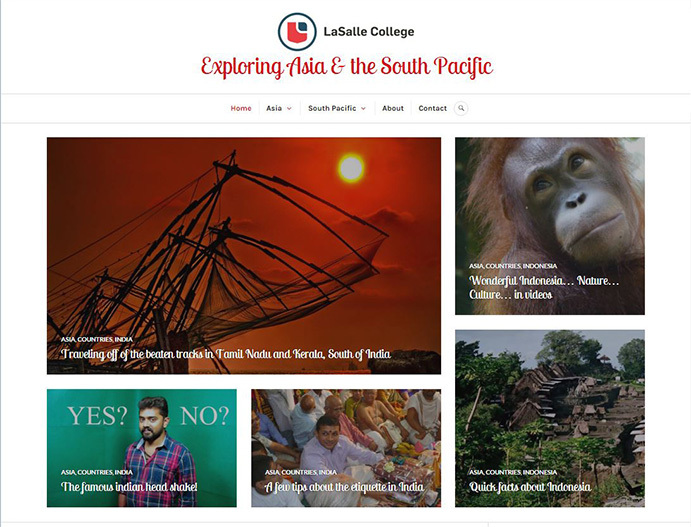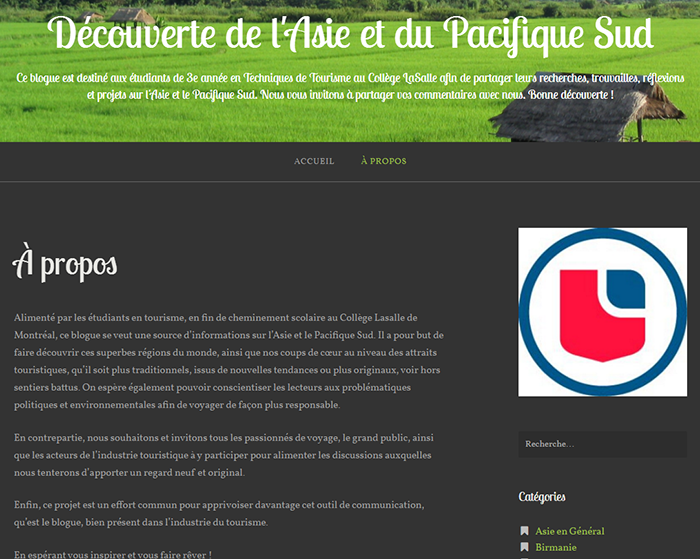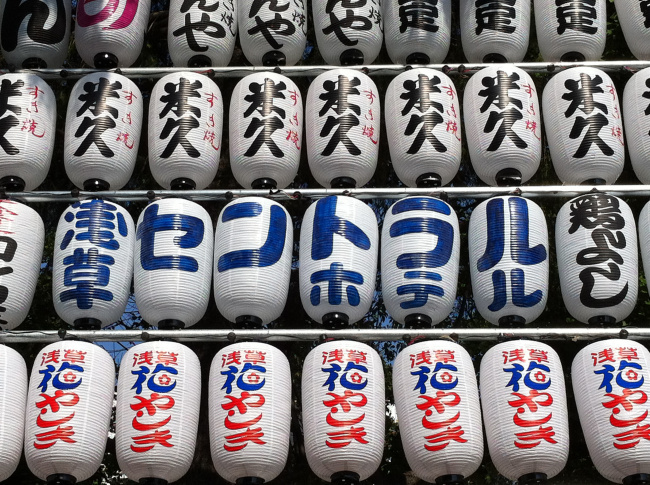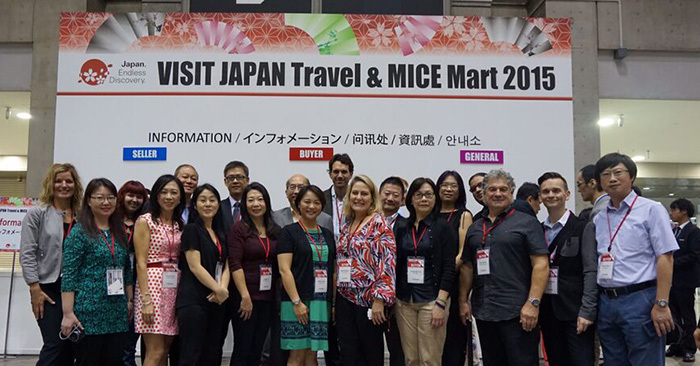Teaching Tourism… From Japan!
In May 2015, Collège LaSalle’s ICT committee sent out a call for proposals to all teachers, inviting anyone interested in integrating technology into their teaching practice to submit a project proposal. At that point, I had just been invited to an Asian tourism trade show and to a familiarization tour of Tokyo, scheduled to take place in the fall of 2015. I applied for a grant and was informed in August that my project had been chosen. This meant I was going to be able to teach a blended course to my “Cultural and Tourist Attractions of Asia and the South Pacific” students, starting in a regular classroom. Then, from September 20th to October 5th, 2015, my classes would be live from Japan!
I had the possibility of teaching remotely using an array of technological tools live from Japan, the international capital of digital and technological innovation! Considering the particularity of the pedagogical content, I had to modify the preparation of my teaching and learning activities, as much for the broadcasting of the course as for ensuring the active participation of my students. Since the motivation and engagement of my students are things that are particularly important to me, I searched for the best strategy to involve them as much, if not more than I normally would for this unusual course.

Tokyo, October 2015
The Blog: Knowledge Serving Competency Development
At the beginning of the semester, I assigned the main project for the course to the students. Each week they would contribute to a collective blog. Since I teach this course to two different groups (one in English and one in French), we created two distinct websites on WordPress. During the demonstration of how the blog works, two students from each group were recruited to check the blog posts. These volunteers were chosen as they were comfortable with the technical aspects. In exchange for their volunteering, these students received a reduced research workload for the content of the blog. They and I had administrator access codes while the rest of the students had “author” codes.

English Students’ Blog

French Students’ Blog
Over the 15 weeks of the course, we covered several cultural and tourist attractions in 11 Asian countries. However, students had to do more detailed research on past and current events in politics and the environment of Thailand, Burma, India and Nepal. The blog was therefore a way to present the information that had been gathered collectively and organize it based on the various aspects and issues experienced in a country, while also linking them to the tourism industry and to sustainable tourism. Here is an example:
- The Indian caste system
- The everyday living conditions of ladyboys in Burma and Thailand
- The prostitution issue in Thailand
- The history and evolution of the tourism industry in the Mount Everest area
- The tsunami of 2004 in Japan
- The situation of the Karen and Padang peoples in Thailand
Conducted within an educational context, this research becomes essential when working as a tour guide or a travel agent, for example. In the Tourism program, we must train students to identify relevant information and to build a sound opinion on those topics, as they will have to discuss the realities of tourism in a country with prospective travelers, or recommend a destination to potential clients.

Lanterns, October 2015
Distinguishing between the nature and use of this public blog versus a private personal blog allowed students to work on their reflective process using issues such as confidentiality and accessibility on the web. This, in turn helped them to build their professional and individual digital identity. I was happy and proud to see the quality of the research and analysis conducted by the students! Their efforts not to judge too hastily are evident everywhere, and the quality of their comments on posts from other students is one of the positive outcomes of this growing awareness. In fact, while commenting, students were invited to:
- Support their arguments by sharing an article
- Make links with their own personal research or experiences
Using this blog also gave students an opportunity to improve the rigorousness of their methodology, especially when publishing content on-line (using images, photographs or videos that are royalty-free). Soon, students will deliver a final presentation on their project, which covers 13 other Asian destinations.
This collective project that was created for a pedagogical purpose has already created a following elsewhere in the world, since some people from Asia are following the blog! This creates another source of motivation for students, as they know their project is read not only by their teacher, but a real audience!
Video Conferences: Being There Despite the Distance
The 30 students from my two groups also had the opportunity to use a video conferencing platform to attend my classes while I was in Japan. During the two weeks I spent there, I taught two-hour classes to each of my groups. For logistical and organizational purposes, it was easier to have the students maintain their original class schedule. Since there is a 13-hour time-zone difference between Japan and Quebec, I had to teach as late as 2 a.m. and as early as 5 a.m. on some occasions!
Students logged on to the Adobe Connect platform to attend the classes. Prior to my departure, we had done a few demonstrations in class with their laptops. All the necessary plug-ins for the platform were downloaded and installed by the college’s IT service to avoid technical problems. The library purchased headsets that the students could borrow for the duration of the online classes (two weeks). Unfortunately since the quality of the Internet connection could not be guaranteed, it was preferable to have students use audio only and to turn off their webcams. To prevent glitches or weak signal issues on my end, I had ordered a Pocket WiFi online. It was delivered to my first hotel with a return envelope to send it back to the college upon leaving the country. This back-up plan provided me with an optimal Internet connection for 12 days at an approximate cost of $100. Back in Montreal, a member of the administration or an Education advisor were on-hand to unlock the computer lab for the students and to supervise the first class.
Once we were accustomed to the logistical aspects and had adapted to this type of virtual interaction, the students and I were ready for class! Each period, for about 20 minutes, I talked about Japan, its culture, and the characteristics of the sites I had visited with the familiarization tour or on my own. I explained how the tourism fair was going and presented the suppliers and organizations I had encountered. Since this class is given as part of the third year of the program, students were very interested in hearing more about the practical aspects of the job. Having the opportunity to speak to them directly from the tourism fair and to let them experience it “through appropriation” was very beneficial for them.

Canadian buyers invited to the Visit Japan Travel & Mice Mart 2015.
I used most of the tools available within the Adobe Connect platform when conducting my classes. This made it possible for the students and myself to:
- Upload files and PowerPoint slideshows to present content to support my lecture
- Write notes on a blank page in the “notebook” area of the interface projected on the screen
- Communicate using the microphone or the live chat tool
Bidirectional communication was a central aspect of my teaching strategy in this class. Traditional lectures are less appropriate since students are learning a trade. In technical programs, I think that it is vital to get students to take action. This allows them to define their professional identity.
Once again, in this ICT project, I was surprised to see the high participation rate of the students, both with the audio and the live chat, as evidenced by their responses to my interventions or when they discussed amongst themselves online. In the context of a traditional class, some shyer students participate little – if at all – while outgoing students fill the void. However, in the context of a synchronous virtual class, live chat becomes a very useful tool that allows everyone to participate actively in each of the classes. I have learned from this experience that it is essential to offer a variety of teaching styles and techniques to meet the needs of all students!

Cheedi Pagoda, Mount Fuji, October 2015
Most of the time, students attended class in the computer lab, but on some occasions students stayed home and told me that they were able to focus better on the course. If I have the opportunity to teach the class again from abroad, it would be interesting to allow students to attend class from home.
I am very satisfied with my experience teaching from beyond my college’s walls. This type of class requires a significant amount of organization, but experimenting with new strategies and varying educational tools can only help the teacher and the students learn! I could not have enjoyed my experience as much as I did without the precious assistance of the ICT committee:
- Julie-Anne Roy and Mathieu Lépine, Education Advisors
- Rosemary Lahey, Instructor
- My fellow teachers in the Tourism program
- Martine Lizotte, Director of the International School of Hotel Management and Tourism
Thanks to their support, I won’t hesitate to try another techno-pedagogical experiment!

